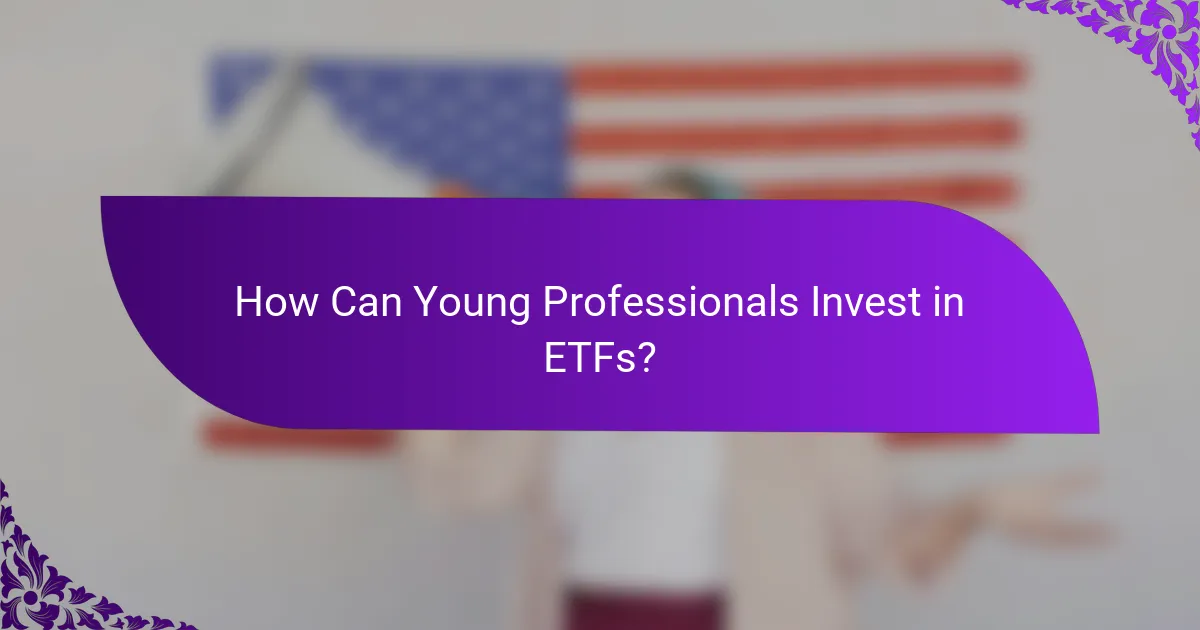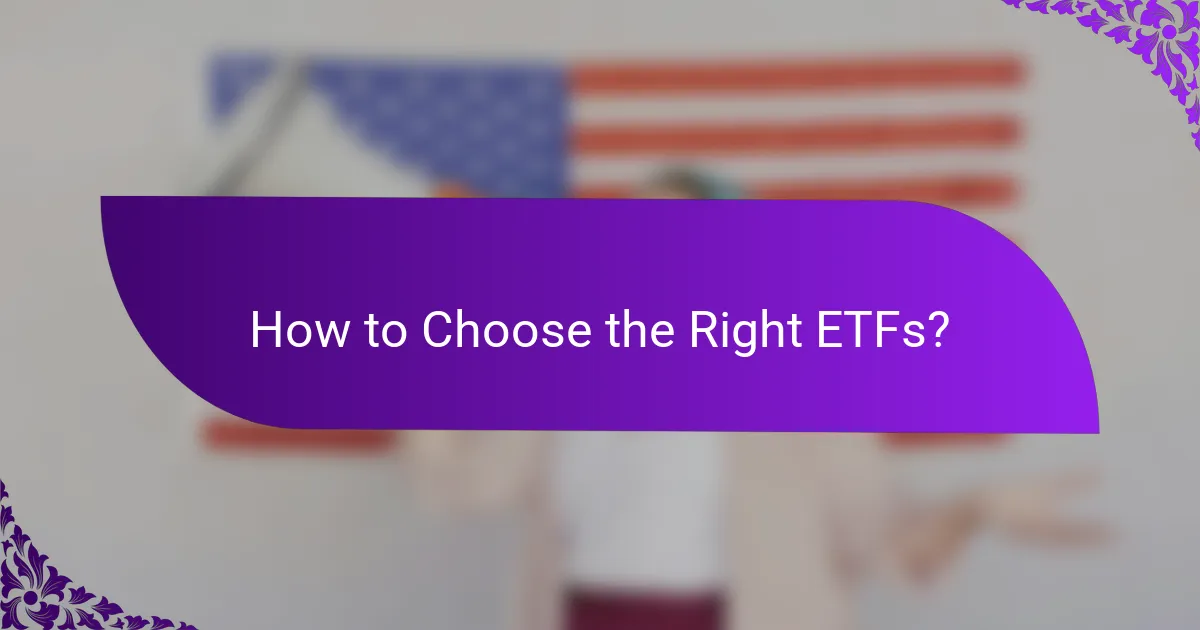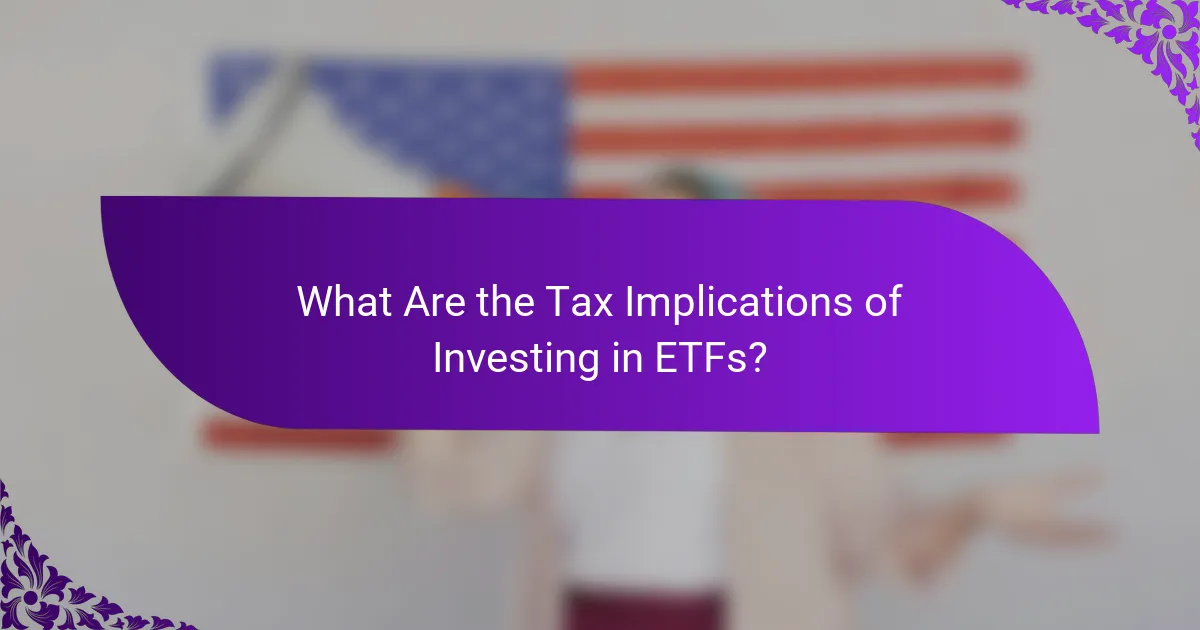Exchange-Traded Funds (ETFs) present young professionals with a compelling investment opportunity due to their low costs, diversification, and tax efficiency. As they embark on their financial journeys, these individuals can utilize various platforms to invest in ETFs, employing strategies like dollar-cost averaging and sector rotation to optimize their returns while managing risk.

What Are the Benefits of ETFs for Young Professionals?
Exchange-Traded Funds (ETFs) offer young professionals a range of advantages, making them an attractive investment option. These benefits include low costs, diversification, tax efficiency, accessibility, and liquidity, all of which can enhance investment strategies for those starting their financial journeys.
Low expense ratios
One of the primary benefits of ETFs is their low expense ratios compared to mutual funds. Many ETFs have expense ratios that are often below 0.5%, allowing investors to keep more of their returns. This cost-effectiveness is particularly beneficial for young professionals who may have limited capital to invest.
When choosing an ETF, look for those with low fees, as high expenses can significantly erode long-term gains. A small difference in expense ratios can lead to substantial differences in investment growth over time.
Diversification opportunities
ETFs provide young investors with easy access to diversified portfolios, which can reduce risk. By investing in a single ETF, you can gain exposure to a wide range of assets, including stocks, bonds, and commodities. This diversification is crucial for balancing risk and reward, especially for those new to investing.
For example, a single ETF may track an index that includes hundreds of companies across various sectors, allowing you to spread your investment across many different areas without needing to buy each stock individually.
Tax efficiency
ETFs are generally more tax-efficient than mutual funds due to their unique structure. They typically generate fewer capital gains distributions, which can lead to lower tax liabilities for investors. This is particularly advantageous for young professionals who may be in higher tax brackets as they advance in their careers.
To maximize tax efficiency, consider holding ETFs in tax-advantaged accounts like IRAs or 401(k)s, where taxes on gains can be deferred or minimized.
Accessibility for small investors
ETFs are accessible to young professionals, often allowing for lower minimum investments compared to mutual funds. Many brokers offer the option to purchase fractional shares of ETFs, enabling investors to start with smaller amounts of capital. This accessibility encourages early investment, which is key for building wealth over time.
Look for brokerage platforms that offer commission-free ETF trading to further enhance affordability and ease of access.
Liquidity advantages
ETFs are traded on stock exchanges, providing liquidity that allows investors to buy and sell shares throughout the trading day. This flexibility is beneficial for young professionals who may need to adjust their investment strategies quickly in response to market changes.
When investing in ETFs, be mindful of the bid-ask spread, as this can impact the overall cost of buying or selling shares. Aim for ETFs with higher trading volumes to minimize these costs and ensure smoother transactions.

How Can Young Professionals Invest in ETFs?
Young professionals can invest in ETFs through various platforms that cater to different investment styles and goals. The most common methods include using brokerage accounts, robo-advisors, and retirement accounts, each offering unique benefits and considerations.
Brokerage accounts
Investing in ETFs via a brokerage account is a straightforward option for young professionals. These accounts allow direct access to a wide range of ETFs, enabling investors to buy and sell shares at market prices. Many brokerages offer commission-free trading for ETFs, which can help minimize costs.
When choosing a brokerage, consider factors such as account fees, available research tools, and the user interface. Popular options include platforms like Charles Schwab, Fidelity, and Robinhood, which cater to different levels of investment experience.
Robo-advisors
Robo-advisors provide a hands-off approach to investing in ETFs, making them ideal for young professionals who prefer automation. These platforms create and manage a diversified portfolio of ETFs based on your risk tolerance and investment goals, often with lower fees than traditional advisors.
Common robo-advisors include Betterment and Wealthfront, which typically charge a small percentage of assets under management. This option is particularly appealing for those who may lack the time or expertise to manage their investments actively.
Retirement accounts
Investing in ETFs through retirement accounts, such as a 401(k) or an IRA, offers tax advantages that can significantly enhance long-term growth. Many employers provide access to ETFs within their retirement plans, allowing employees to invest pre-tax dollars.
When using retirement accounts, be mindful of contribution limits and withdrawal rules. For instance, IRAs have annual contribution limits that can change, while 401(k) plans often have employer matching contributions, which can boost your investment potential. Always consider your long-term financial goals when choosing this investment route.

What Strategies Should Young Professionals Use with ETFs?
Young professionals can effectively use ETFs by employing strategies like dollar-cost averaging, sector rotation, and value investing. These approaches help manage risk while maximizing potential returns over time.
Dollar-cost averaging
Dollar-cost averaging involves consistently investing a fixed amount of money into an ETF at regular intervals, regardless of its price. This strategy reduces the impact of market volatility and can lead to purchasing more shares when prices are low and fewer when prices are high.
For example, if you invest $200 monthly in an ETF, you will buy more shares during market dips and fewer during peaks. Over time, this can lower your average cost per share, making it a practical approach for young investors with limited capital.
Sector rotation
Sector rotation is a strategy that involves shifting investments among different sectors of the economy based on their performance and economic cycles. Young professionals can take advantage of this by monitoring economic indicators and reallocating their ETF investments accordingly.
For instance, during economic expansions, sectors like technology and consumer discretionary may perform well, while in downturns, defensive sectors like utilities and healthcare may be more resilient. This approach requires ongoing research and market awareness but can enhance returns by capitalizing on sector trends.
Value investing
Value investing focuses on purchasing undervalued ETFs that are trading below their intrinsic value. This strategy requires identifying ETFs that represent companies with strong fundamentals but are currently overlooked by the market.
Young professionals can look for ETFs that track indices of undervalued stocks or sectors. A common heuristic is to consider ETFs with low price-to-earnings (P/E) ratios compared to their peers. This approach can lead to significant long-term gains as the market corrects itself and these undervalued assets appreciate.

What Risks Should Young Professionals Consider with ETFs?
Young professionals should be aware of several risks when investing in ETFs, including market volatility, tracking error, and liquidity risks. Understanding these factors can help mitigate potential losses and enhance investment strategies.
Market volatility
Market volatility refers to the fluctuations in the price of securities, which can significantly impact the value of ETFs. Young professionals should be prepared for periods of rapid price changes, which can lead to both gains and losses.
To manage this risk, consider diversifying your ETF investments across various sectors or asset classes. This can help cushion against sharp declines in specific markets. Additionally, maintaining a long-term investment perspective can reduce the emotional impact of short-term volatility.
Tracking error
Tracking error is the difference between the performance of an ETF and the performance of its benchmark index. A high tracking error can indicate that the ETF is not effectively replicating the index it aims to follow, which may lead to unexpected returns.
When selecting an ETF, look for those with low tracking errors, typically under 1%. Review the fund’s historical performance and expense ratios, as higher costs can contribute to greater tracking errors. Understanding the ETF’s methodology can also provide insights into its potential effectiveness.
Liquidity risks
Liquidity risks arise when an ETF cannot be easily bought or sold without affecting its price. Low trading volumes can lead to wider bid-ask spreads, increasing the cost of entering or exiting a position.
To avoid liquidity issues, choose ETFs that have higher average trading volumes and assets under management. These funds tend to have better liquidity, making it easier to execute trades at favorable prices. Always check the ETF’s average daily volume before investing to ensure it meets your liquidity needs.

How to Choose the Right ETFs?
Choosing the right ETFs involves evaluating factors like expense ratios, fund performance, and underlying assets. These elements can significantly impact your investment returns and risk exposure.
Expense ratios
Expense ratios represent the annual fees that fund managers charge investors, expressed as a percentage of the fund’s assets. Lower expense ratios are generally better, as they leave more of your investment returns intact. Aim for ETFs with expense ratios below 0.5% to maximize your gains.
When comparing ETFs, consider that even a small difference in expense ratios can lead to significant savings over time. For example, an ETF with a 0.2% expense ratio versus one with a 0.5% can save you hundreds of dollars over several years, especially with larger investments.
Fund performance
Fund performance refers to how well an ETF has historically performed compared to its benchmark index. Look for ETFs that have consistently outperformed their benchmarks over various time frames, such as 1, 3, and 5 years. This can indicate strong management and a solid investment strategy.
However, past performance is not a guarantee of future results. Consider the market conditions during the performance periods and whether the ETF’s strategy aligns with your investment goals. A well-performing ETF in a bull market may not perform as well in a bear market.
Underlying assets
Underlying assets are the securities that an ETF holds, which can include stocks, bonds, or commodities. Understanding the composition of these assets is crucial, as it affects both risk and return. For example, an ETF focused on technology stocks may offer high growth potential but also higher volatility.
When selecting an ETF, review its holdings to ensure they align with your risk tolerance and investment strategy. Diversification within the underlying assets can help mitigate risk. Look for ETFs that provide exposure to a range of sectors or asset classes to balance your portfolio effectively.

What Are the Tax Implications of Investing in ETFs?
Investing in ETFs can have various tax implications that young professionals should understand. Generally, ETFs are treated as pass-through entities, meaning that any capital gains or income generated are passed on to investors and taxed accordingly.
Tax Treatment of Capital Gains
When you sell an ETF for more than you paid, you realize a capital gain, which is subject to taxation. Long-term capital gains, applicable if you hold the ETF for over a year, are typically taxed at lower rates compared to short-term gains, which are taxed as ordinary income. Understanding these distinctions can help you plan your investment strategy effectively.
Dividends and Interest Income
ETFs may distribute dividends or interest income, which are also taxable. Qualified dividends, usually from U.S. corporations, are taxed at the long-term capital gains rate, while non-qualified dividends are taxed at your ordinary income rate. Keeping track of the type of income generated by your ETFs is crucial for accurate tax reporting.
Tax-Advantaged Accounts
Investing in ETFs through tax-advantaged accounts like IRAs or 401(k)s can defer taxes on gains and income until withdrawal. This strategy allows your investments to grow without immediate tax burdens, making it a beneficial option for young professionals looking to maximize their long-term growth potential.
Common Tax Pitfalls
One common pitfall is failing to consider the tax implications of selling ETFs, especially in taxable accounts. Another is overlooking the impact of dividend distributions on your overall tax liability. To avoid surprises, keep detailed records of your transactions and consult a tax professional if needed.
